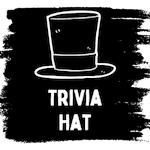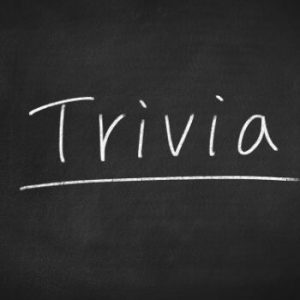Here you’ll find find a compilation of some of the best science trivia questions and answers. They all vary in terms of difficulty, from easy to hard, making sure there’s a science question for every level. How much of a ‘brainiac’ are you?
137 Science Trivia Questions with Answers
1.What is the only rock that floats?
Pumice – it has an average porosity of 90%, and initially floats on water.
2. What is the only bone in the human body that isn’t attached to any other bone?
Hyoid bone – located in the throat.
3. Which planet will you find between Jupiter and Uranus?
Saturn. It is the sixth planet in our solar system.
4. What is the study of fungi called?
Mycology
5. Pascal is a measure of what?
Pressure
6. What is the best-selling personal computer model of all time?
Commodore 64 – 17 million units with a 1 MHz processor and 64KB RAM
7. What is the longest muscle in the human body?
Sartorious – from the pelvis to just below the inside of the knee.
8. How many orbits has the Sun made around the center of the Milky Way Galaxy in its life?
About 20
9. Who first proposed the concept of contact lenses?
Leonardo da Vinci
10. What planet in our solar system has the shortest day?
Jupiter – 10 hours
11. What is the equivalent megapixels of the human eye?
576 megapixels
12. Approximately 2% of all people have what eye color?
Green – Brown is 55%; hazel and blue are 8% each.
13. How many constellations are in the night sky?
88
14. What are the four states of matter observable in everyday life?
Solid, liquid, gas, plasma
15. What is the largest two-digit prime number?
97
16. Marble is formed by the metamorphosis of what rock?
Limestone
17. What is the densest naturally occuring element?
Osmium – about 25 times denser than water
18. In its natural form, aspirin comes from the bark of what tree?
White willow tree
19. What metal has the highest melting point?
Tungsten – 6,192 degrees Fahrenheit
20. How many times does the Moon revolve around the Earth in a year?
13
21. What is the smallest organ in the human body?
Pineal gland – in the center of the brain
22. What is the largest 3-digit prime number?
997
23. The European organization for nuclear research is known by what four letters?
CERN – from the French “Conseil Europeen pour la Recherche Nucleaire”
24. What planet in our solar system has the longest day?
Venus – 243 Earth days
25. What are metals not considered precious called?
Base metals
26. What is the only planet in our solar system less dense than water?
Saturn
27. An astronomical unit is defined by what distance?
Earth to the Sun – 93 million miles
28. Located near the root of human hair follicles, the arrector pili muscles are responsible for what phenomenon?
Goosebumps
29. What figure has four sides all the same length but no right angles?
Rhombus
30. What was the name of the first electronic general-purpose computer?
ENIAC – 1946
31. What blood type qualifies as a universal donor?
O negative
32. What year was the first email sent?
1971
33. What is the only tree that grows in saltwater?
Mangrove
34. Most of the world’s supply of cork comes from what type of tree?
Oak – cork oak trees predominantly in Portugal and Spain
35. Due to its unique chemical qualities, what natural food can remain in an edible form for centuries?
Honey – 3,000-year-old edible honey has been found in tombs.
36. What is the smallest named time interval?
Planck time – 5.39 x 10–43 seconds
37. What is the effect of the Earth’s rotation on the wind called?
Coriolis
38. What is the most abundant metal in the Earth’s crust?
Aluminum
39. What name is given to a chemical reaction that takes in heat?
Endothermic
40. Who formulated the laws which first explained the movements of the planets properly?
Johannes Kepler
41. What color is at the top of a rainbow?
Red – Violet is at the botoom.
42. What gives onions their distinctive smell?
Sulfur – when cut or crushed, a chemical reaction changes an amino acid to a sulfur compound.
43. What is the brightest star in the night sky?
Sirius – Dog Star
44. What standard international unit of power is equal to 1.341 horsepower?
Kilowatt
45. What is the number 10 to the power of 100 called?
Googol
46. What element is named after the Greek word for green?
Chlorine
47. What name is given to the socket in the human skull that holds the eye?
Orbit
48. How many vertebrae in the human spine?
33
49. The atomic mass in the periodic table is stated relative to the weight of what element?
Carbon – more specifically carbon-12
50. What is the standard international unit of force?
Newton – one newton equals the force needed to accelerate one kilogram of mass at the rate of one meter per second squared.
More Science Trivia
51. From what plant is the heart drug digitalis obtained?
Foxglove
52. The phenomenon where hot water may freeze faster than cold is known as what?
Mpemba Effect
53. What is the most abundant element in the universe?
Hydrogen – about 75 % of the universe’s mass
54. What is the opposite of nocturnal?
Diurnal
55. Stonehenge is made of what two main types of rock?
Bluestone and sandstone
56. The Saffir-Simpson scale measures the intensity of what?
Hurricanes
57. How long is an eon?
1 billion years
58. What is the name for the point in a planet’s orbit when it is nearest the Sun?
Perihelion
59. What is the name of the process where plants lose water into the atmosphere?
Transpiration
60. What part of the human body is the axilla?
Armpit
61. In the electromagnetic spectrum, what comes between X-rays and visible light?
Ultraviolet light
62. What is the practice of concealing a file, message, image, or video within another file, message, image, or video called?
Steganography
63. After calcium, what is the second most abundant mineral in the human body?
Phosphorus
64. What are the Magellanic Clouds?
Galaxies
65. Lateral epicondylitis is the medical name for what common medical condition?
Tennis elbow
66. Who is the author of ‘Coming of Age in Samoa’, the mostly widely read book in the field of anthropology?
Margaret Mead
67. From what plant is the poison ricin obtained?
Castor oil plant
68. What is an apparatus that converts molecules into ions and separates the ions according to their mass-to-charge ratio called?
Mass spectrometer
69. What is rayon made from?
Wood pulp
70. On the periodic table, what is the first element alphabetically?
Actinium
71. What does AM stand for on radios?
Amplitude modulation
72. How much longer is a day on Mars than a day on Earth?
40 minutes
73. Where on the human body are the most sweat glands?
Bottom of the feet
74. The chemical formula H2O2 refers to what?
Hydrogen peroxide
75. What is the point in the Moon’s orbit that is farthest from the Earth called?
Apogee
76. After nitrogen and oxygen, what is the third most abundant gas in the atmosphere?
Argon
77. What species is the oldest living individual tree?
Bristlecone pine – 5,000 years
78. What metal is the best conductor of electricity?
Silver – It is slightly more conductive than copper but much more expensive.
79. Who discovered X-rays?
Wilhem Roentgen
80. What is the only part of the human body that cannot repair itself?
Teeth
81. Thomas Edison was involved in a rivalry over which form of electricity would be commercialized; Edison supported direct current; who was his rival that supported alternating current?
Nikola Tesla
82. The Big Dipper is part of what constellation?
Ursa Major of Great Bear
83. Who invented carbonated soda water?
Joseph Priestley – also discovered oxygen
84. What is the male part of a flower called?
Stamen
85. What are the four types of adult human teeth?
Incisors, canines, premolars, molars
86. Where does Earth rank in size among the planets in our solar system?
Fifth
87. Syncope is the medical name for what condition?
Fainting
88. What element has the lowest boiling point?
Helium – negative 452.1 degrees Fahrenheit
89. What is the heaviest naturally occuring element?
Uranium
90. Who invented the exploding shell?
Henry Shrapnel
91. During hot or dry periods, what is the equivalent of hibernation?
Estivation
92. The process where food browns during cooking is known as what?
Maillard reaction
93. What number on the Richter scale does an earthquake have to reach to be considered major?
Seven
94. What scale is used to measure the hardness of minerals?
Mohs scale
95. On what planet, other than Earth, did a man-made object first land?
Mars
96. What color has the longest wavelength in the visible spectrum?
Red
97. Where in the human body is the labyrinth?
Ear
98. What is the largest nerve in the human body?
Sciatic
99. What does the human lacrimal gland produce?
Tears
100. The Fahrenheit and Celsius temperature scales are the same at what temperature?
40 degrees below zero
101. What device converts alternating current into direct current?
Rectifier
102. The small intestine is made up of jejunum, ileum, and what?
Duodenum
103. What scale is used to measure wind speed?
Beaufort
104. What planet is often called the Earth’s twin because it is nearly the same size and mass and has similar composition?
Venus
105. A positive number that equals the sum of its divisors excluding itself is called what?
Perfect number
106. What is saffron made from?
Crocus flowers – only the stigma part of the flower is used; it takes 70,000 to 250,000 flowers to make one pound of saffron.
107. What is the second largest planet in our solar system?
Saturn
108. The heat of chili peppers is measured in what?
Scoville Heat Units
109. The density of what is measured on the Ringelmann Scale?
Smoke
110. What two planets in our solar system don’t have moons?
Mercury and Venus
111. What is the lightest known solid element?
Lithium
112. The Fields Medal is awarded for achievement in what field?
Mathematics
113. What is extracted from the ore cinnabar?
Mercury
114. Who is the Bluetooth wireless technology named after?
King Harald “Bluetooth” Gormsson – He ruled Denmark in the 10th century.
115. What medical condition is detected using the Ishihara test?
Color blindness
116. What condition is singultus?
Hiccups
117. In computing, what is the half of a byte called?
Nibble
118. What sense is most closely linked to memory?
Smell
119. What are the only two elements that are liquid at room temperature?
Mercury and bromine
120. What is the only rock that floats in water?
Pumice
121. Hansen’s disease is more commonly known as what?
Leprosy
122. What is the second hardest gem after diamond?
Sapphire
123. Au is the chemical symbol for which metal?
Gold
124. Which planet of the Solar System orbits closest to the sun?
Mercury
125. The ulna and humerus are bones in which part of the body?
The arm
126. What is the branch of medicine that deals whith the manufacture of artificial body parts?
Prostethics
127. The patella is the scientific name for which bone of the human body?
Kneecap
128. What is measured using the decibel scale?
The loudness of sound
129. The thalamus, cerebrum and cerebellum are found in which organ of the body?
The brain
130. What is the most abundant element in the universe?
Hydrogen
131. True or false – alkalis have a pH level below 7?
False
132. By what name is ethanol more commonly known?
Alcohol
133. Botany is the scientific study of what?
Plants
134. NaCI is the chemical formula of which common substance?
Salt
135. What is the fourth planet from the sun?
Mars
136. Solar energy is made from heat or light from what?
The sun
137. Which travels faster, light or sound?
Light





